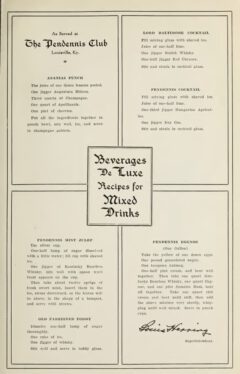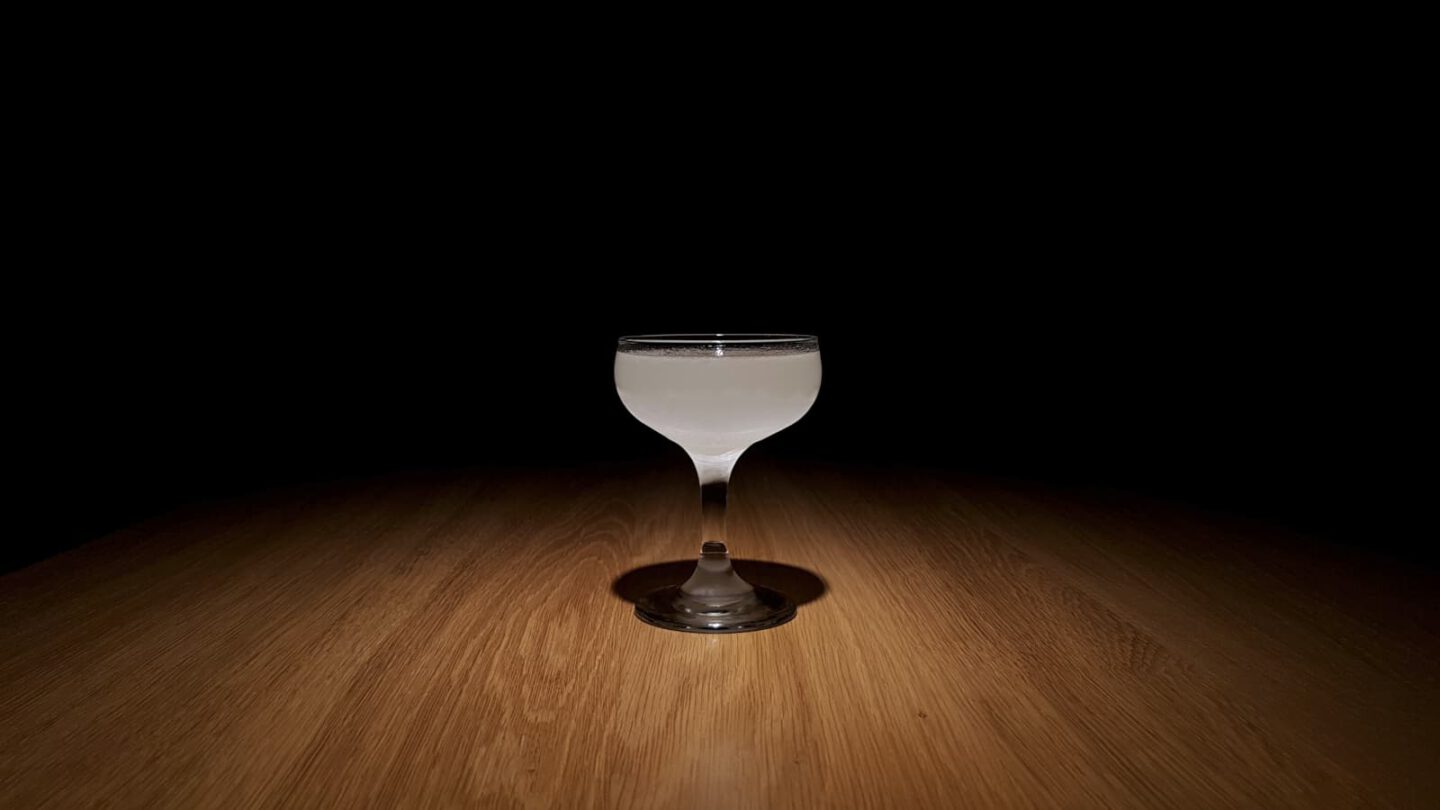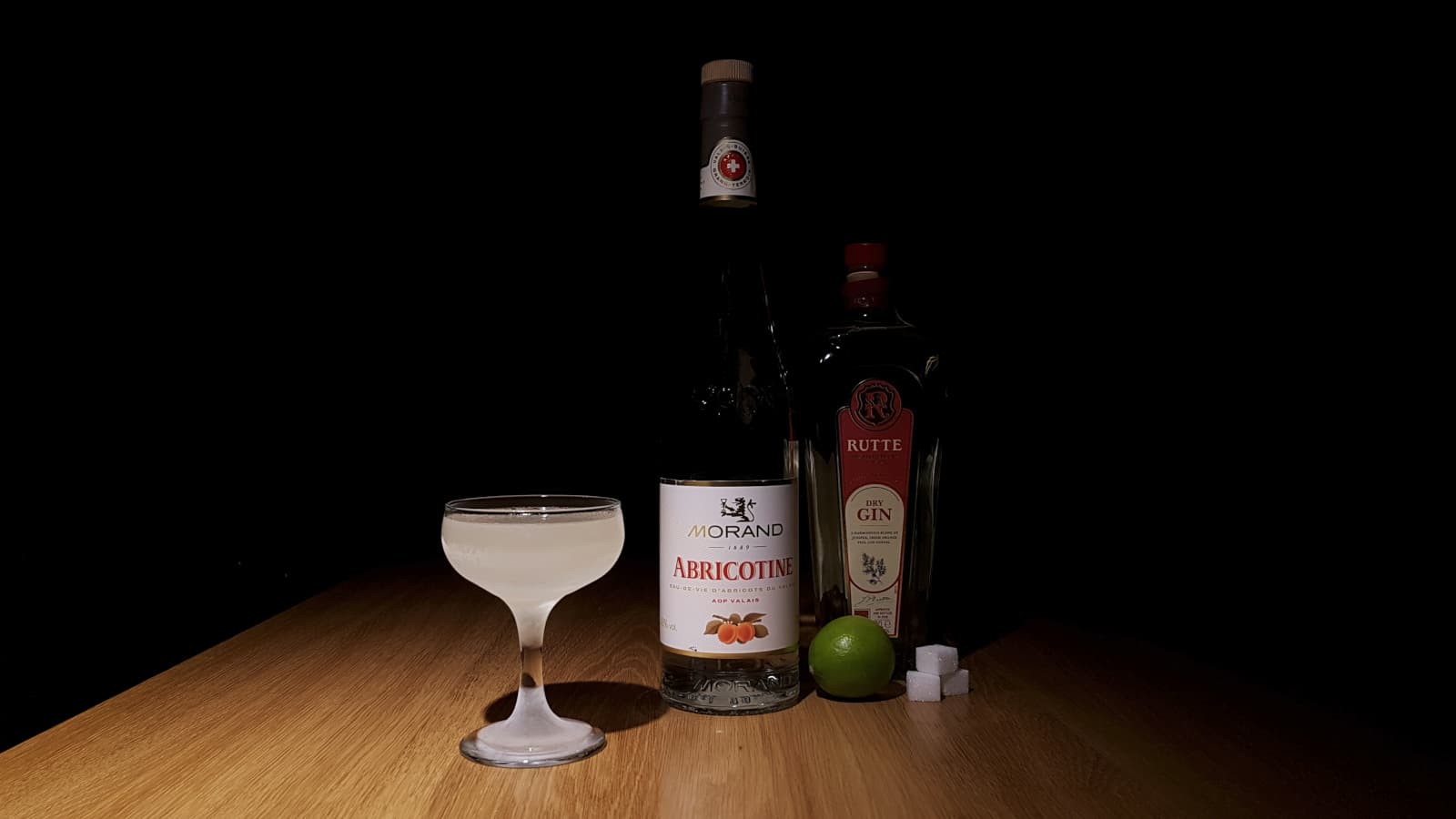![]() The Pendennis Club did not produce the Old-Fashioned Cocktail, but around 1910 the Pendennis Cocktail, a combination of gin, apricot brandy, lime juice and optional Peychaud’s bitters, did.
The Pendennis Club did not produce the Old-Fashioned Cocktail, but around 1910 the Pendennis Cocktail, a combination of gin, apricot brandy, lime juice and optional Peychaud’s bitters, did.
60 ml Rutte dry gin
20 ml Morand Apricotine
15 ml lime juice
10 ml sugar syrup (2:1)
Preparation: Shaken.
Alternatively and currently preferred by us:
60 ml Finsbury 47 Gin
20 ml Schwarzer Marille
15 ml lime juice
10 ml sugar syrup (2:1)
2,5 ml water
Preparation: 3 ice cubes, shaken for 10 seconds (30 times). Note: The Pendennis shows how sensitive fruit eau-de-vie can be. If shaken too long, the flavour disappears. If you shake for a shorter time, some of the melt water may be missing. To compensate for this, we add additional water to the recipe.

We first found the Pendennis Cocktail in Beverages de Luxe, published in 1911, in Louisville, where the Pendennis Club is located. In this book, individual bars are listed and each of them presents some drinks served at them. On page 61, the manager of the Pendennis Club, Louis Herring, introduces six mixed drinks served at his club: Ananias Punch, Lord Baltimore Cocktail, Old Fashioned Toddy, Pendennis Mint Julep, Pendennis Eggnog and the Pendennis Cocktail, which is made with the juice of half a lime, or about 15 ml, 20 ml of Hungarian Abricotine and 60 ml of Dry Gin. [1] Abricotine is originally a fruit eau de vie made from Wallis apricots. [2] In this recipe, no bitters are added yet. This is first done by Charles H. Baker in 1939. His recipe calls for 60 ml of dry gin, 30 ml of apricot brandy, the juice of one lime, which is about 30 ml, and 2 dash of Peychaud’s bitters. In 1912, William Boothby uses a mixture of 30 ml Plymouth gin, 15 ml apricot brandy and 15 ml French vermouth. He also refers to the Pendennis Club. Jacques Straub, however, calls such a cocktail a “Van Zandt Cocktail” in 1913.

The Pendennis Club Cocktail was created at the Pendennis Club in Louisville, Kentucky. There seem to be a few ambiguities and variations in the recipe. We stick to the one attested to by the Pendennis Club’s director in 1911 with his printed signature, and expand it to include the Peychaud’s bitters brought into play by Charles H. Baker.
It is impossible to say for sure when the cocktail was created, but we can assume. Jacques Straub was the manager of the Pendennis Club before Louis Herring. When the Blackstone Hotel was built in Chicago between 1908 and 1910, Jacques Straub moved to Chicago to set up the wine cellar for the hotel. In 1913 he published his work “A Complete Manual of Mixed Drinks”. The Pendennis Toddy is in it, but the Pendennis Cocktail is missing. According to his own account, his book contains over 675 recipes of mixed drinks as served in the best hotels, bars and clubs. [4] In such a monograph, the Pendennis Cocktail would certainly have been included if Jacques Straub had known it from the Pendennis Club. This suggests that the cocktail was created after Jacques Straub had left the Pendennis Club. This narrows down the time of origin to the years 1910 or 1911.
Sources
- George R. Washburne & Stanley Bronner: Beverages De Luxe. Louisville, The Wine And Spirit Bulletin, 1911.
- https://de.wikipedia.org/wiki/Abricotine: Abricotine.
- https://en.wikipedia.org/wiki/File:Pendennis_club_c1906.jpg: The old Pendennis Club building in Louisville, Kentucky circa 1906.
- Jacques Straub: A Complete Manual of Mixed Drinks For All Occasions. This book contains over 675 clear and accurate directions for mixing all kinds of popular and fancy drinks, served in the best hotels, clubs, buffets, bars and homes. Added to this there is a splendid introduction on wines, their medicinal value, when and how to serve them, kinds and styles of glasses to use and other valuable information and facts of great importance to every user of wines and liquors. Chicago, R. Francis Welsh Publishing Co., 1913

Historical recipes
1911 George R. Washburne & Stanley Bronner: Beverages De Luxe. Pendennis Cocktail.
As Served at The Pendennis Club Louisville, Ky.
Fill mixing glass with shaved ice.
Juice of one-half lime.
One-third jigger Hungarian Apricot-
ine.
One jigger Dry Gin.
Stir and strain in cocktail glass.
1912 William Boothby: The World’s Drinks. Anhang. Pendennis Club Cocktail.
(LOUISVILLE, KY.)
One-quarter Apricot brandy, one-quarter French Vermouth, one-half
Coates Plymouth gin; shake well, and serve very cold.
1914 George R. Washburne & Stanley Bronner: Beverages De Luxe. Pendennis Cocktail.
Fill mixing glass with shaved ice.
Juice of one-half lime.
One-third jigger Hungarian Apri-
cotine.
One jigger Dry Gin.
Stir and strain in cocktail glass.
1927 Anonymus: El arte de hacer un cocktail. Seite 162. Pendennis.
Disuélvase 1/2 terrón de azúcar con po-
quito de agua en vaso grande.
Vasito de whiskey Bourbon.
Pedazo de hielo.
1930 William T. Boothby: „Cocktail Bill“ Boothby’s World Drinks. Seite 66. Pendennis.
Gin . . . . . . . . . . . 1/2 jigger Apricot Brandy . . . . 1/4 jigger
. Fr. Vermouth . . . . . 1/4 jigger
Shake well with ice, strain into chilled cocktail glass and serve.
1931 Albert Stevens Crockett: Old Waldorf Bar Days. Seite 167. Three-To-One.
Reminiscent of a favorite term among conservative
race-track bettors.
One-half Lime Juice
One-third Apricot Liqueur
Two-thirds Dry Gin
Frappé
1934 William T. Boothby: „Cocktail Bill“ Boothby’s World Drinks. Seite 17. Apricot, No. 2.
Gin . . . . . . . . . . . . 2/3 jigger Apricot Cordial . . . 1/3 jigger
. Lime . . . . . . . . . . 5 drops
Shake well with ice, strain into chilled cocktail glass and serve.
1934 William T. Boothby: „Cocktail Bill“ Boothby’s World Drinks. Seite 131. Pendennis.
Gin . . . . . . . . . . . 1/2 jigger Apricot Brandy . . . . 1/4 jigger
. Fr. Vermouth . . . . . 1/4 jigger
Shake well with ice, strain into chilled cocktail glass and serve.
1939 Charles H. Baker, Jr.: The Gentleman’s Companion. Seite 81. The Pendennis Club’s Famous Special.
To 1 jigger of dry gin add 1/2 jigger of the best dry apricot brandy
procurable. Squeeze in the juice of 1 lime or 1/2 a small lemon, strained
of course, and trim with 2 dashes of Peychaud’s bitters which has been
made for generations in New Orleans …. Split a ripe kumquat, now
available during the winter in most big grocery or fruit stores; take
out the seeds and put the 2 halves in a Manhattan glass. Stir the drink
like a Martini with lots of cracked ice and strain onto the golden fruit.
This is a sweeter Grande Bretagne, see Page 47.
Seite 47. Grande Bretagne.
THE GRANDE BRETAGNE COCKTAIL No. I, BEING to OUR
UNGOVERNED MIND ONE of the FIVE or SIX CHIEF COcKTAILS of the
WHOLE WIDE WORLD
One dank, chilly, and snow-carpeted day in January of 1931 we
wore out shoe leather, shins, and temper in the name of “history” and
“art,” hiking all over the Acropolis in Athens; skidding from the
Temple of Diana, around the Parthenon, and back down past the
Erectheum and its divine caryatids, and to our motor car and to
Athens proper. Here we met Eddie Hastings, now cruise director for
the M.S. BREMEN with Raymond-Whitcomb, and he told me about
the little Greek barkeep in his tiny bar and his miraculous inventions.
. . . This Grecian male had been abarring for over 40 years, man and
boy. During that time he had devoted 1/2 hr daily to the pardonable
indoor pastime of testing new and radical mixes all his own. The
Grande Bretagne Nos. I and II, were the final result – the pinnacle.
Using lime juice we found later is far better than lemon, although
lemon is plenty good enough. Use dry imported apricot brandy, never
the sweet syrupy American copy …. No. I: 1 jigger of the best dry
gin possible, 1/2 pony apricot brandy, 1/2 pony or so of strained lime or
lemon juice, 1 tsp of very fresh egg white, 1 dash of orange bitters.
Shake with lots of ice and turn into a chilled Manhattan glass. . . .
No. II: substitute kirschwasser for apricot brandy, omit orange bit-
ters – using 1 dash of peach bitters if available, or 1 tsp Cordial Médoc.
The domestic Bridge Table cocktail, the 3-to-One, both copy this
Grande Bretagne, but the apricot brandy content is too heavy, and no
mention is ever made that unless fine dry apricot brandy is used, the
result is sweet, abortive, disillusioning in the extreme. . . . It is amaz-
ing, though, how such a small amount of apricot or kirsch comes
zipping through to lend bouquet to this brisk drink.
1946 Charles H. Baker, Jr.: The Gentleman’s Companion. Seite 81. The Pendennis Club’s Famous Special.
To 1 jigger of dry gin add 1/2 jigger of the best dry apricot brandy
procurable. Squeeze in the juice of 1 lime or 1/2 a small lemon, strained
of course, and trim with 2 dashes of Peychaud’s bitters which has been
made for generations in New Orleans …. Split a ripe kumquat, now
available during the winter in most big grocery or fruit stores; take
out the seeds and put the 2 halves in a Manhattan glass. Stir the drink
like a Martini with lots of cracked ice and strain onto the golden fruit.
This is a sweeter Grande Bretagne, see Page 47.
Seite 47. Grande Bretagne.
THE GRANDE BRETAGNE COCKTAIL No. I, BEING to OUR
UNGOVERNED MIND ONE of the FIVE or SIX CHIEF COCKTAILS of the
WHOLE WIDE WORLD
One dank, chilly, and snow-carpeted day in January of 1931 we
wore out shoe leather, shins, and temper in the name of “history” and
“art,” hiking all over the Acropolis in Athens; skidding from the
Temple of Diana, around the Parthenon, and back down past the
Erectheum and its divine caryatids, and to our motor car and to
Athens proper. Here we met Eddie Hastings, now cruise director for
the M.S. BREMEN with Raymond-Whitcomb, and he told me about
the little Greek barkeep in his tiny bar and his miraculous inventions.
. . . This Grecian male had been abarring for over 40 years, man and
boy. During that time he had devoted 1/2 hr daily to the pardonable
indoor pastime of testing new and radical mixes all his own. The
Grande Bretagne Nos. I and II, were the final result – the pinnacle.
Using lime juice we found later is far better than lemon, although
lemon is plenty good enough. Use dry imported apricot brandy, never
the sweet syrupy American copy …. No. I: 1 jigger of the best dry
gin possible, 1/2 pony apricot brandy, 1/2 pony or so of strained lime or
lemon juice, 1 tsp of very fresh egg white, 1 dash of orange bitters.
Shake with lots of ice and turn into a chilled Manhattan glass. . . .
No. II: substitute kirschwasser for apricot brandy, omit orange bit-
ters – using 1 dash of peach bitters if available, or 1 tsp Cordial Médoc.
The domestic Bridge Table cocktail, the 3-to-One, both copy this
Grande Bretagne, but the apricot brandy content is too heavy, and no
mention is ever made that unless fine dry apricot brandy is used, the
result is sweet, abortive, disillusioning in the extreme. . . . It is amaz-
ing, though, how such a small amount of apricot or kirsch comes
zipping through to lend bouquet to this brisk drink.
1948 Trader Vic: Bartender’s Guide. Seite 165. Pendennis Cocktail – 1.
1 oz. dry gin Juice 1/2 lime
1/2 oz. apricot brandy 1 dash Peychaud’s bitters
Shake with cracked ice; strain into chilled cocktail glass.
1948 Trader Vic: Bartender’s Guide. Seite 165. Pendennis Cocktail – 2.
1 oz. dry gin 1/2 oz. apricot brandy
. 1/2 oz. French vermouth
Shake with cracked ice; strain into chilled cocktail glass.
1953 Anonymus: Esquire’s Handbook for Hosts. Seite 124. Pendennis Cocktail.
3/4 oz. Hungarian apricot brandy
1/2 oz. gin
Add the juice of one lime or lemon
2 dashes of Peychaud bitters
Pour the mixture over cracked ice,
strain into cocktail glasses.
1972 Trader Vic: Trader Vic’s Bartender’s Guide. Seite 99. Pendennis Cocktail – 1.
1 ounce gin
1/2 ounce apricot brandy
Juice of 1/2 lime
1 dash Peychaud bitters
Shake with ice cubes. Strain into chilled cocktail glass.
1972 Trader Vic: Trader Vic’s Bartender’s Guide. Seite 99. Pendennis Cocktail – 2.
1 ounce gin
1/2 ounce apricot brandy
1/2 ounce French vermouth
Shake with ice cubes. Strain into chilled cocktail glass.
1977 Stan Jones: Jones’ Complete bartender’s Guide. Seite 362. Pendennis.
Cocktail Glass Shake
1-1/2 oz gin
3/4 oz peach brandy
1 dash peach bitters
1 oz lemon (or lime) juice
Variation
1 oz gin
3/4 oz apricot brandy
3/4 oz dry vermouth
2009 Ted Haigh: Vintage Spirits and Forgotten Cocktails. Seite 228. The Pendennis Cocktail. 6 cl gin; 3 cl apricot brandy; 1-3 dashes Peychaud’s Bitters; 2 cl lime juice.
2014 David Kaplan, Nick Fauchald, Alex Day: Death & Co. Seite 148. Pendennis Club Cocktail. 2 ounces Plymouth gin; 3/4 ounce Pendennis mix; 3/4 ounce lime juice; 2 dashes House Peychaud’s bitters; garnich: 1 lime. Seite 284, Pendennis mix: 2 ounces simple syrup; 1 ounce Marie Brizard apricot liqueur; 2 teaspoons Marie Brizard crème de peche. Seite 284, House Peychaud’s bitters: 2 parts Peychaud’s bitters, 1 part The Bitter Truth creole bitters.
2016 André Darlington & Tenaya Darlington: The New Cocktail Hour. Seite 80. Pendennis Club. 60 ml Old Tom Gin (Hayman’s); 30 ml apricot brandy (Rothman & Winter); 22 ml lime juice; 3 dashes Peychaud’s bitters; garnish: lime wheel.
explicit capitulum
*


Hi Armin,
Great article and it strongly concurs with my own research except in one instance that throws off some of your sleuth work. The first appearance of the Pendennis Club Cocktail was in 2008 in Bill Boothby’s World’s Drinks and the same recipe that you describe from 1912.
Some people have said that they can’t find this in the book but it is in the Appendix.
all the best,
noel
Hi Noel,
thanks for letting me know. There is a slight problem with the editions. Both, the 1908 and the 1912 edition, show on the title page the year “1908”. I guess someone forgot to update it for the “latest edition” of 1912. The appendix is only in the “latest edition” not in the edition which has written “1908” also on the front cover. At least that’s the result of my research. What is written on the front cover of your edition?
Cheerio,
Armin